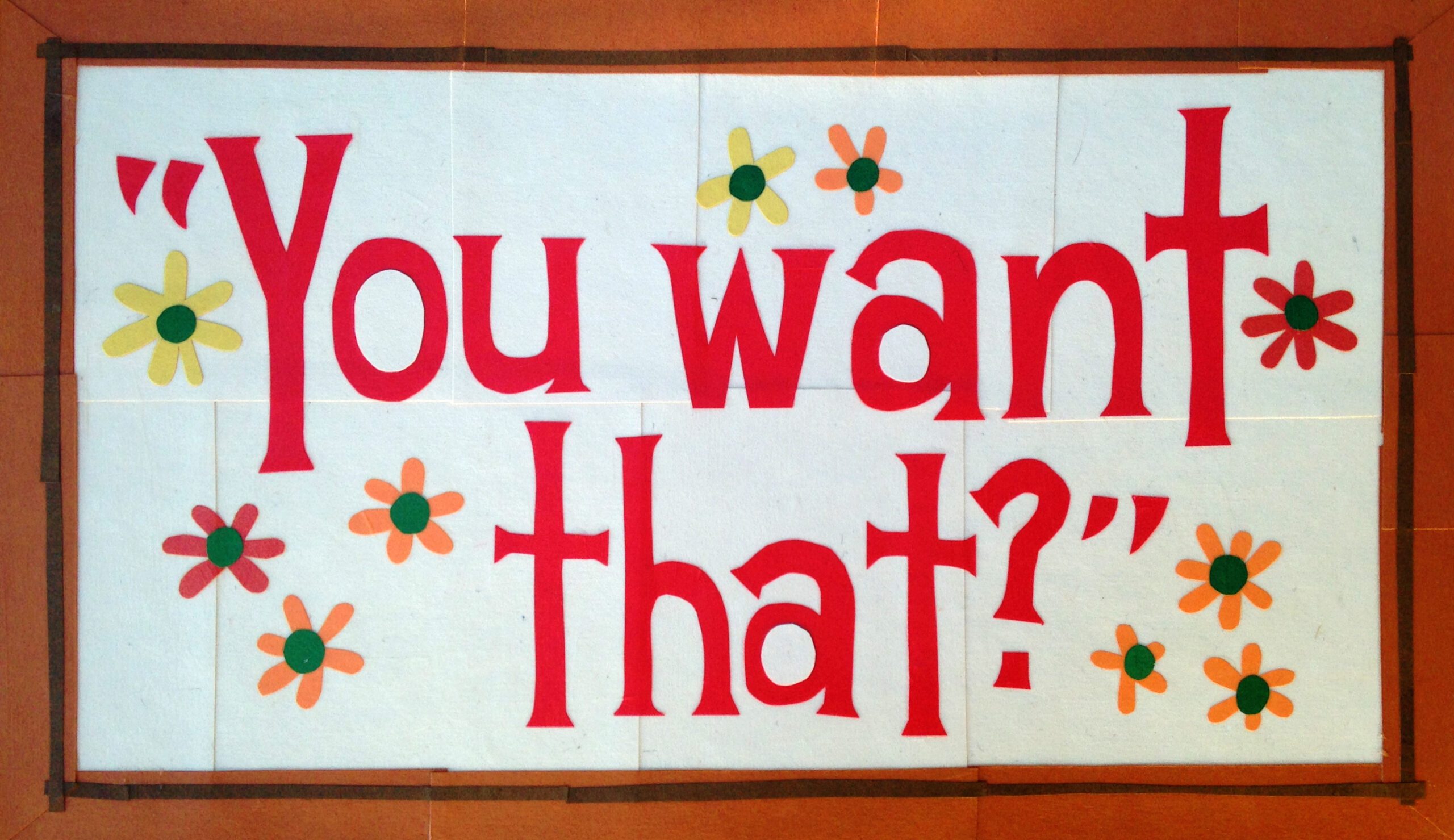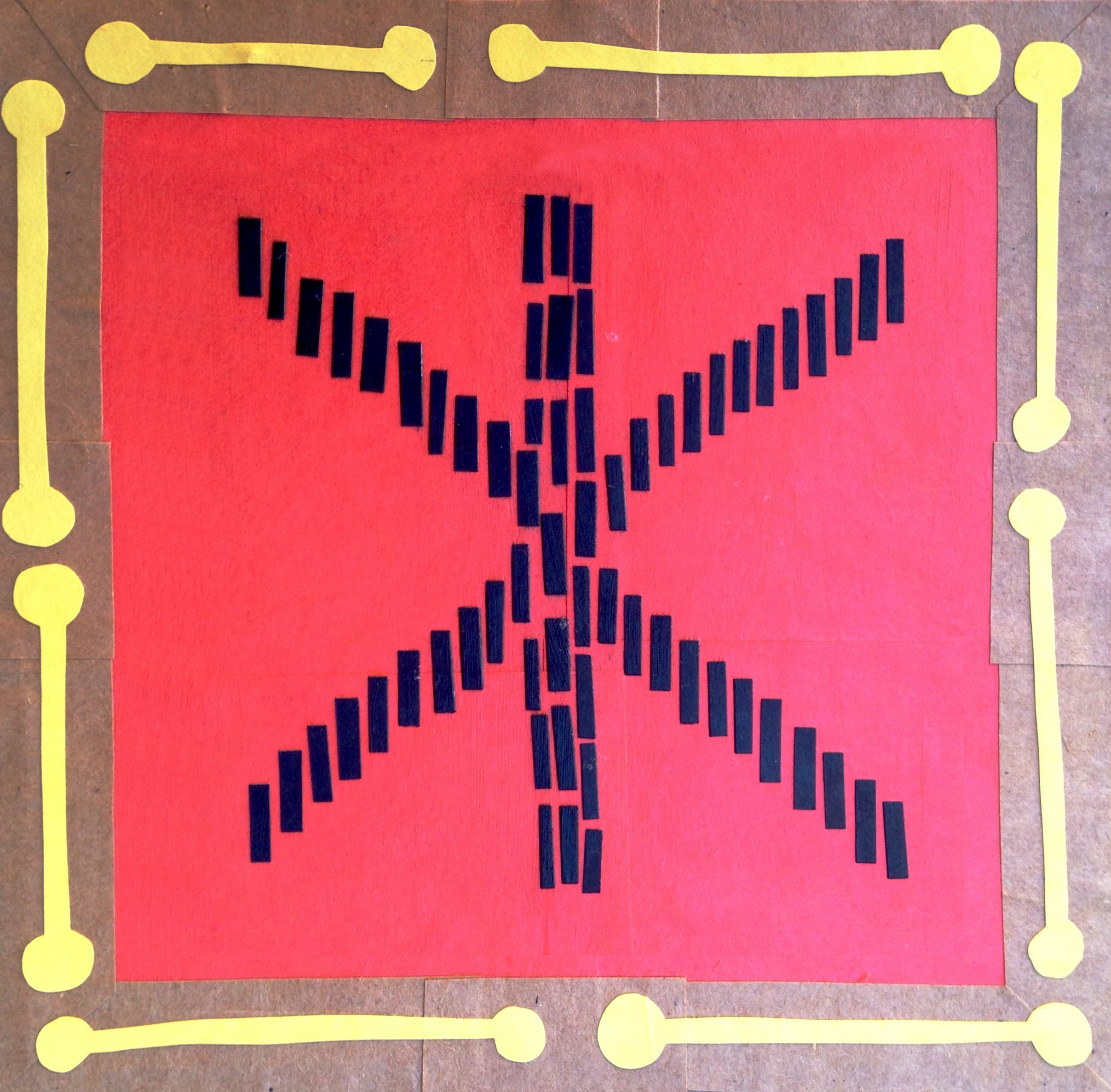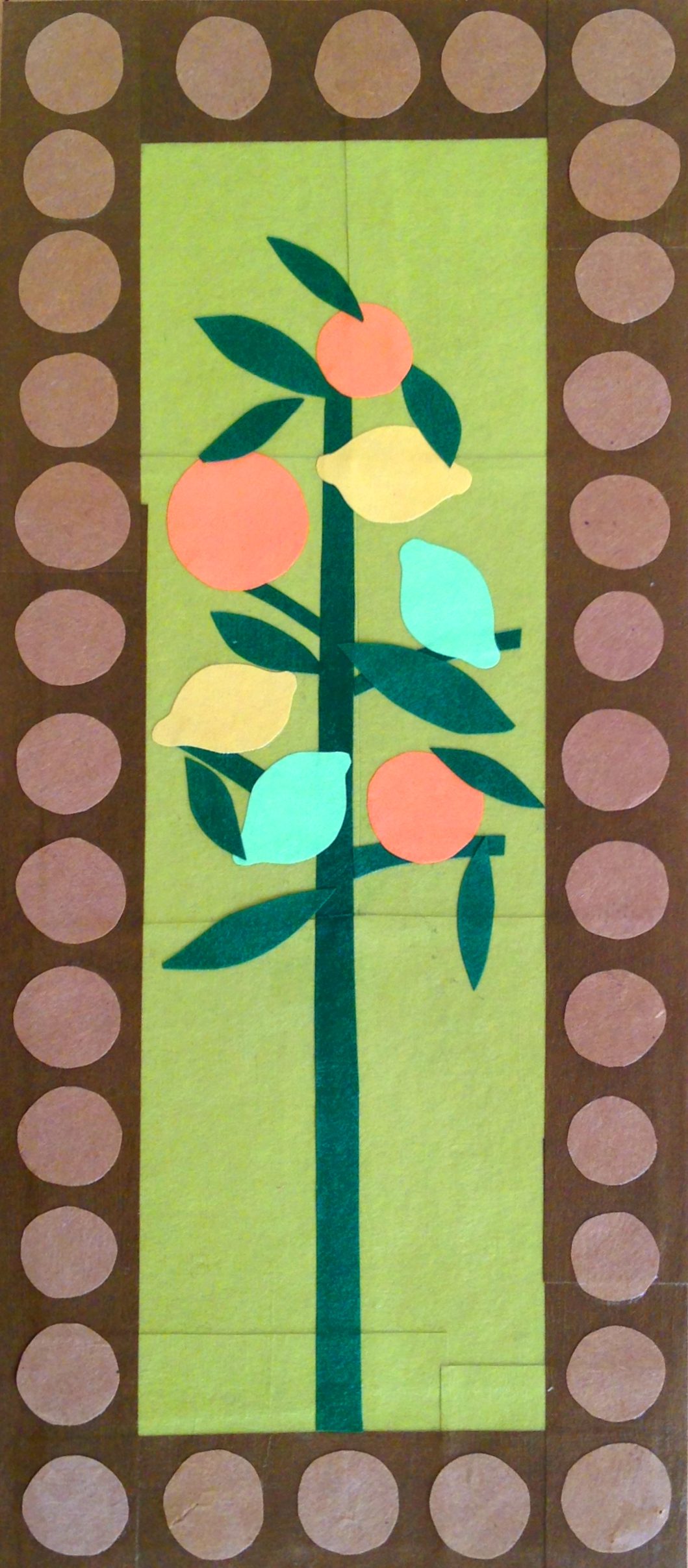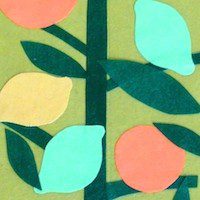After my grandma died it wasn’t long before my grampap was unable to live on his own in the house he’d built into the side of a hill in southwestern Pennsylvania, and before moving plans started getting made, my sisters placed claims on quilts, framed photographs, pieces of jewelry, and the more salvageable furniture, leaving for my inheritance two plastic cereal bowls and all the tools in the carport. I was a recent college graduate living in Pittsburgh in a frigid one-bedroom at the top of a creaking house just one hour from my grandparents’, and when I visited their place for the last time I made a claim of my own: the tri-color citrus tree done in yarn on a swath of coarse green linen that hung by the mothballed closet of the upstairs guest bedroom. I pulled it off the wall. It weighed less than a pair of shoes. On the backing paper Grandma had written a reminder in pencil: Christmas 1975. Pam made it.
“You made this?” I asked my mother.
“You want that?” she said.
It fit easily inside my two-door coupe. I was, at the time, into kitsch, and the orange, yellow, and sea foam green of the yarn matched an afghan I’d picked up somewhere. I hung it near the TV, where I’d see it easiest. Across the room hung a painting of a woman in cutoff denim and a bandanna skullcap playing the violin wrong-handedly in the middle of a woodlot: Appalachian Serenade. I’d stapled a mess of postcards across the gable eaves that rose over my bed. I lived alone, the bed never shared. I wrote art criticism and rarely saw my family in Virginia.
 Four years later I was living in Lincoln and sharing my bed with Neal, who one weekend took me up to Sioux Falls to meet his family. Neal owned antiques and was able to see in a piece of furniture or bit of design things that otherwise stayed invisible to me until pointed at with a finger. The lines of a couch’s architecture. The glimmering depth which made a car’s finish metallic. That weekend, we took a break from his family and drove across town to one of his favorite antique stores, owned and operated by a white-haired couple with a Maytag-sized cage behind the counter filled with the kind of birds that looked highlighted and shrieked. The place was enormous but uncluttered, and back rooms had buckets of water on the floor below missing ceiling tiles, and in the depths of those rooms I found a three-piece bedroom suite that reminded me of the furniture of my grandparents’ upstairs guest bedroom. Sliding doors in the bed’s headboard exposed shadowy nooks for books or paraphernalia. It was, as I’d learned, midcentury but not, as I was still figuring out, collectible. Over the bed high up on the wall was a three-foot square piece of art: a shrub done in Kelly green and navy yarn on a field of olive drab linen.
Four years later I was living in Lincoln and sharing my bed with Neal, who one weekend took me up to Sioux Falls to meet his family. Neal owned antiques and was able to see in a piece of furniture or bit of design things that otherwise stayed invisible to me until pointed at with a finger. The lines of a couch’s architecture. The glimmering depth which made a car’s finish metallic. That weekend, we took a break from his family and drove across town to one of his favorite antique stores, owned and operated by a white-haired couple with a Maytag-sized cage behind the counter filled with the kind of birds that looked highlighted and shrieked. The place was enormous but uncluttered, and back rooms had buckets of water on the floor below missing ceiling tiles, and in the depths of those rooms I found a three-piece bedroom suite that reminded me of the furniture of my grandparents’ upstairs guest bedroom. Sliding doors in the bed’s headboard exposed shadowy nooks for books or paraphernalia. It was, as I’d learned, midcentury but not, as I was still figuring out, collectible. Over the bed high up on the wall was a three-foot square piece of art: a shrub done in Kelly green and navy yarn on a field of olive drab linen.
I bought it for its size. It barely fit in the trunk of my mid-size car. I took it home and hung it in a corner of the kitchen opposite my mother’s citrus tree and only then saw what I’d begun.
Nobody knows the origin of the word crewel, a worsted yarn whose name led to crewelwork, the term I learned over time that gives my mother’s citrus tree its category. To make crewelwork, one embroiders yarn into linen. That the 17th century was crewelwork’s “heyday” is yet another thing Wikipedia is, as of this writing, wrong about. The browned, grassy palette of the crewelwork I’ve seen places it decidedly in the Vietnam War era. The soft textures warranted soft subjects. Flowers predominate. Trees and birds. As a word, crewel is too homophonic and so in talking about it I’ve preferred the richly assonant yarn art. Crewelwork is historic. Yarn art is pop. These are distinctions I make in order to present myself as someone further from what I know myself to be: finicky and effete. I haven’t gone by David since the eighth grade, for instance. Crafting, historically, is women’s work, and kitsch is for queers, and early in my adolescence I learned how well an ironic stance could keep me distanced from anything true, such that when in eighth grade gym a sevvie called me a boy bop I said, “Yeah like that’s even a word,” and went back to clapping hands with my friend Emily.
This is the story I tell quickly but with pride when people step into my office, which has since two homes ago been where all the yarn art goes: My mom made that one piece and I found that big piece at an antique store and suddenly I realized I had a collection going. My yarn art brands me as a collector, and this, I’m afraid, is one of those essays that looks at what I am to try to understand who I’ve been.
*
Here, after an asterisk, is the place in a personal essay where I’d probably describe a piece from my collection. I’d start with the frame, capturing both the color (“English teeth”) and the surface of the wood (“collarbone-thin”, “chips and dents around all four edges as though gnawed on by a giant baby”), before moving on to the art itself, the scene or subject it depicts (“a mouse wearing a housecoat and apron with a dustpan in her hands looking askance at an unclothed ant”) and the textures of the yarn over the rough linen surface (“tight and nappy, like the vel side of Velcro”), and I’d do it all using everything I’ve learned from show don’t tell. I’d let it stand alone, this description, between another asterisk, the way each piece of yarn art stands alone but near another on my office walls. Thus, I’d have here a segmented essay in which form iterates content in a way that might sparkle the eyes of a Pushcart judge.
 Recently, a colleague heard my yarn art story and said, “Oh, I didn’t know your mother made one. Your collection has that thing. That thing they talk about on Antiques Roadshow.” I couldn’t think of it either. “You should write an essay about it,” he said. I sighed, seeing the essay laid out before me. The need for segmentation. The waxing lyrical on the ties between my mother and me. The punning off crewel. And throughout it all, the humble tone and posed vulnerability which would serve to mask my self-absorption. I couldn’t imagine unleashing that on other people, and I told him so.
Recently, a colleague heard my yarn art story and said, “Oh, I didn’t know your mother made one. Your collection has that thing. That thing they talk about on Antiques Roadshow.” I couldn’t think of it either. “You should write an essay about it,” he said. I sighed, seeing the essay laid out before me. The need for segmentation. The waxing lyrical on the ties between my mother and me. The punning off crewel. And throughout it all, the humble tone and posed vulnerability which would serve to mask my self-absorption. I couldn’t imagine unleashing that on other people, and I told him so.
Minutes later we were out in the hallway of our campus building, walking toward my office. A kid in sweats and a T-shirt with earbuds sprouting out the sides of his head looked up at us. “Sorry,” he said. “I overheard your conversation. Is the word you’re looking for ‘provenance’?” He rhymed it with ‘providence’.
“Oh, provenance,” said the two gay professors.
*
I got the Mausfrau piece on a street corner one Saturday in Chelsea, after I haggled the wizened man in a blousy leather jacket down to $15 from $20. I walked off feeling proud, savvy, like some big-city ringer, when in actuality what I was was a guy who dropped $15 on an 11×11 piece of yarn art that had along its right edge a water stain in the shape of a macrocephalic snowman. Do I expect it to appreciate in value? Mausfrau’s my favorite and I hang it above my desk where I can see it easiest. It’s underneath my mother’s citrus tree and next to the thin one of three tall sunflower stalks which, when set on the floor, comes up to my chin. That one I bought at a furniture shop in Lincoln, and two years later I bought a replica at a meager estate sale in Tuscaloosa. Another year later I passed a third at an antique store in Conway, Arkansas, and last year I saw it on TV. It should be clear from this that the piece I bought in Lincoln, the piece that’s become my second favorite, is not mine, that what I’ve collected here is not a work of art or even craft but rather a mass-produced good, the way other men have collected beer cans or toys in their original packaging. But the sunflower piece of yarn art I bought is mine. All twenty-four of them are. I show them off to guests. I enjoy my collection surrounding me on four walls the way Imelda Marcos must have done with her 3,000 shoes, which is to say greedily, which brings us to avarice.
In 2012, 12 people became billionaires in America while 250 thousand people fell below the poverty line, and so we understand that the eager desire to get or keep for oneself is thriving. It’s a deadly sin, if you believe in those sorts of things, but here in our country we don’t. We believe in achievement. We believe in free markets. We watch Hoarders to feel better about our own poverty. The gift of the hoarder is that he, like a billionaire, has quantitatively more than we do but, unlike a billionaire, qualitatively less. We don’t want what the hoarder’s got. We don’t envy the hoarder his vast but meager collection. We pity it. We feel, from experience, that it’s better to have less.
Pity, then, my poor pieces of yarn art, a handful of which even I don’t want. For years they were easy to find and cheap to buy, and I could always find a few more square inches of wall space, and as a room-girding array they make a visual impact, but who could put a price on this collection? Who would want to? I can give you its provenance, I can tell you the story, but can I make you swoon as I do over the one in the gilt frame depicting a scene from Jonathan Livingston Seagull? I haven’t had success in person. The net of associations that have led this piece to be so important to me is knotted with inside jokes and whims that can’t bear scrutiny, and so how can I expect to have success on the page? What is an essay than a collection of ideas and memories the essayist does her damnedest to get the reader to swoon over? In some essays, we come to adopt these ideas as our own, and thus we envy the essayist her greed, her collection. In other essays, we don’t do this. In personal essays, we don’t even have to. Even the roughest memories, the worst ideas, seem to gain credence when rendered craftfully, when behind them sounds an earnest, searching voice.
If it’s a gift I’ve never been given it, the ability to see the moments of one’s own past as valuable to other people. Best to lock those cluttered rooms up. Let the forgettable be forgotten.
I will never sell my collection, unless of course the price is right.
*
I have an Italian butcher. I have an owl sitting on an outcropping birch branch in front of a pale orange moon. I have a smiling raccoon lying at the base of some cornstalks. Up in the corner of my office there’s a tiny elephant frolicking under a thin, bowed shrub. Or maybe up in the corner there’s an elephant frolicking far behind the shrub. Most yarn art’s lousy at perspective. Most essays, too. It takes a lot of yarn fore and aft to work in the kinds of textures needed to show some depth to the subject. Otherwise you’re left with the thing and the thing only. Daisies in a jar. Wildflowers surging through barbed wire. My mother and what she once made.
How hard it is to separate a thing from how it looks! I’ve nearly given up thinking I can ever be vulnerable in an essay, not because I won’t risk it, but because I don’t know how I can. Writing is the easiest, most consequence-free way to bare the naked soul. It’s not your lover’s face. It’s not your mother. Vulnerable’s etymology ties to wounds and physical injury, so when I’m surrounded by my ideas and when I’m delivering them to a receptive audience it’s hard to feel the way Gary Gilmore did, hooded before a firing squad. That is, it’s wrong to feel this way. To publish opens the personal essayist to possible attack—attack from strangers (often anonymous)—but no real injury, and thus what might seem at first like attack is more like attention, and why publish other than to get attention, to show off what one’s amassed on the page, like so many shoes in a closet?
*
My grampap was a handsome WWII vet who spent most of his life driving a truck for a natural gas company. He liked to pose in old photos, always in braces and tie, usually with a foot up on a stoop or car bumper. He felt he had to flirt with most waitresses. The times I had with him were spent mostly at the truck stop in Bentleyville where each morning after the bowl of corn flakes my grandma would pour him he’d drive his enormous luxury sedan to meet his twin brother Randy for a cup of coffee. I drank chocolate milk, endured gentle ribbing and questions about school, and was given a dollar in quarters to spend on the game machines in the lobby. In adolescence I grew my hair out and wore clothes meant to snatch others’ attention, and I couldn’t be bothered to wake up early enough in the mornings to continue joining my grampap on his truck stop visits. One night over Easter weekend, as we all got ready to ride in his car to the mall, I wore over some alt-rock T-shirt three or four pendant necklaces. “You gonna wear those?” he asked, face scrunched as though smelling some shit.
“Yeah,” I said. “So?”
“So you’re not my grandson if you wear those things.”
At the time I relished this dismissal, this excuse not to be the grandson of some backward hick that did nothing interesting with his life, but these days I have to work to recollect the whole exchange. My hurt, I knew, was a performance of hurt, and the truth was that by that age I didn’t care enough for him to care what he felt about me. Raymond E. Myers spent his last decade in a number of nursing homes, growing more cantankerous and impossible to understand during the annual Christmas-day phone calls my mom would urge on us kids, before he died one night in January 2012. I didn’t go to his funeral. I didn’t want to. I couldn’t easily afford the flight, and when my sister called to say that she’d pay for us to fly up (“Because it’s family, Dave, and money’s not as important as family”) I claimed that the semester had just started and that I couldn’t miss classes.
 I could’ve missed all the classes I wanted to, but my mom, when she’d first called with the news, had said “You don’t have to come up,” and I took it to mean a lot of things. I took it to mean she understood that I didn’t hold any feelings for my grampap, not because of who he was but because of who I was, because I was the son who didn’t cry at funerals, the son who didn’t cry ever, the son who always confounded her for this reason. I took it to mean that she’d prefer to keep her gay son and his partner out of the way of relatives I remain closeted to, not because of who I am but because of who my parents are, not proud enough or strong enough to let these people know I’ve been living with the man I love for six years now. I took it to mean I wasn’t supposed to push her on this, that when I left Virginia at 18 I’d put myself in the position of the absent son, and this was another way I’d be left to play my role.
I could’ve missed all the classes I wanted to, but my mom, when she’d first called with the news, had said “You don’t have to come up,” and I took it to mean a lot of things. I took it to mean she understood that I didn’t hold any feelings for my grampap, not because of who he was but because of who I was, because I was the son who didn’t cry at funerals, the son who didn’t cry ever, the son who always confounded her for this reason. I took it to mean that she’d prefer to keep her gay son and his partner out of the way of relatives I remain closeted to, not because of who I am but because of who my parents are, not proud enough or strong enough to let these people know I’ve been living with the man I love for six years now. I took it to mean I wasn’t supposed to push her on this, that when I left Virginia at 18 I’d put myself in the position of the absent son, and this was another way I’d be left to play my role.
The curse of being a writer is knowing other people. I need other people (to write about) but I can’t handle other people (the way I can literary characters). One way to avoid learning how to handle other people is to write about the self, but everything about this spells defeat. I loved my grampap begrudgingly and not enough. I dream often of that house he built. Once, it was being swallowed up by an overgrown lawn, the walkways blocked by rusty sheets of scrap metal he couldn’t find a way to sell. Another time it had become a writer’s retreat, with old friends and former students milling about the rooms in which I once sought plastic Easter eggs. I remember it being my last afternoon there, not just at the retreat but at the house itself, that for dream-logic reasons I wouldn’t be able to return, and as Neal pushed me inexplicably in a wheelchair out to the parking lot I looked back over my shoulder and saw it had grown enormous, an Alhambra rising from Appalachian pastureland. “Do you think you’ll sleep on the plane?” Neal asked me, and that’s when I started sobbing, my throat racked, my chest in tremors, my breath completely gone.
The question of loss is that I don’t know which is sadder: mourning a loss every waking day, or having lost but never really knowing it. The memories I hold onto of that house are fond ones. Every memory I have is my own. No matter how honed my faculties, I cannot get you to care as I do about the basement bedrooms with floors of cold concrete and door-less doorways, the burnt tinder smell of the kitchen pantry, the rattlesnake whine of the furnace as it kicked on, or the analeptic slope of the hill that ran from the carport to the neighbor’s cow pasture, but I would do anything to have them around again. That I only have one piece of that house to look at, a kitschy citrus tree in a rickety wooden frame, tells me everything I need to know about why people write personal essays, and why I’ll never get it right.
***
Rumpus original art by Paige Russell.





4 responses
As someone who struggles with social anxiety, the lines about knowing and needing other people, but not being able to handle them, put something into perspective for me that I’d never been able to articulate. As a writer, I also sympathize with Dave’s concern about getting readers to care about what I care about. That’s why I write mostly fiction, and sometimes poetry. I guess I wanted to thank Dave for writing this, and let him know I think he did get it right. And I think all writing comes from a place of loss, and our job as writer is to reconcile that loss with the life that must come afterwards.
Yes, you did get it right, and based on my own experience, it is far better to mourn every waking day. Every one.
I don’t want to get it right. I want to get it real. Thanks for getting it real, Dave.
*salutes*
I’ve been struggling to find words that encapsulate feelings so close to these. Both about the life that have slipped by, and my own need/inability to try and make words that matter to people. This piece is…this. Just this. You nailed it.
Click here to subscribe today and leave your comment.